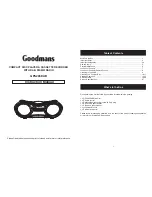
-28-
Model W1864/W1865 (For Machines Mfd. Since 02/19)
O
PE
R
ATIO
NS
Chip.Marks.or.Indentations
Problem:.
Chip indentation or chip bruising is the
result of wood chips not being ejected from the
machine. Instead they are carried around the
cutterhead, deposited on the planed surface and
crushed by the outfeed roller. Some causes of
chip indentation are:
•.
Wood chips/sawdust not being properly
expelled from the cutterhead.
•.
The type of lumber being planed. Certain
species have a tendency to chip bruise.
•.
High moisture content (over 20%) or surface
moisture (refer to
Workpiece.Inspection
).
•.
Dull knives/inserts.
•.
Excessive depth of cut.
Solution:
•.
Use a proper dust-collection system; adjust
chip deflector in or out as necessary.
•.
Lumber must be completely dry, preferably
kiln-dried (KD). Air-dried (AD) lumber must
be seasoned properly and have no surface
moisture. DO NOT surface partially-air-
dried (PAD) lumber.
•.
Make sure planer knives/inserts are sharp.
•.
Reduce depth of cut.
Pitch.&.Glue.Build-up.
Problem:.
Glue/resin buildup on the rollers and
cutterhead will cause overheating by decreasing
cutting sharpness while increasing drag in the
feed mechanism. This can result in scorched
lumber, uneven knife/insert marks, and chatter.
Solution:.
Clean the rollers and cutterhead.
Rippled.Cut.
Problem:.
Regularly spaced indentations across
face of workpiece are caused by excessive
outfeed roller pressure or excessive feed rate.
Solution:.
Reduce outfeed roller pressure; reduce
feed rate.
Summary of Contents for W1864
Page 73: ...Model W1864 W1865 For Machines Mfd Since 02 19...
Page 76: ......
















































